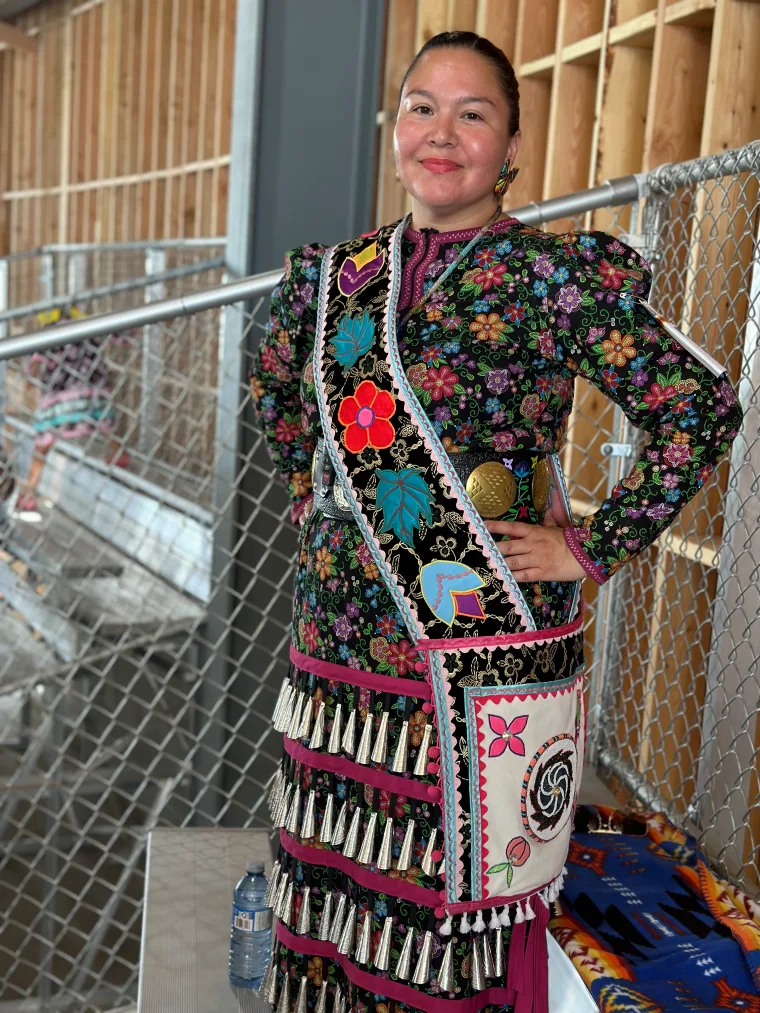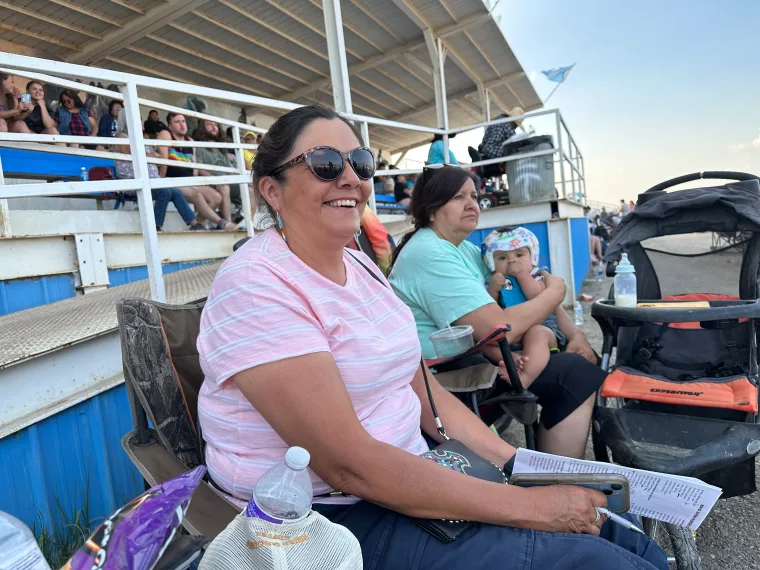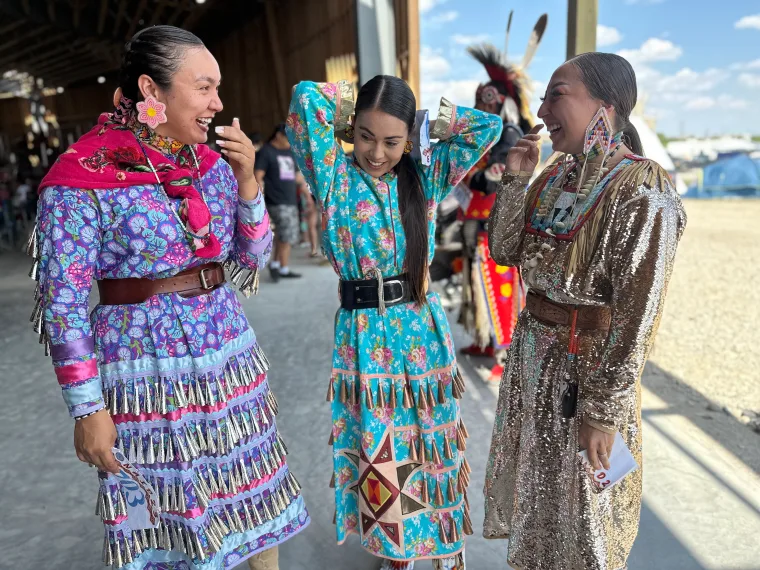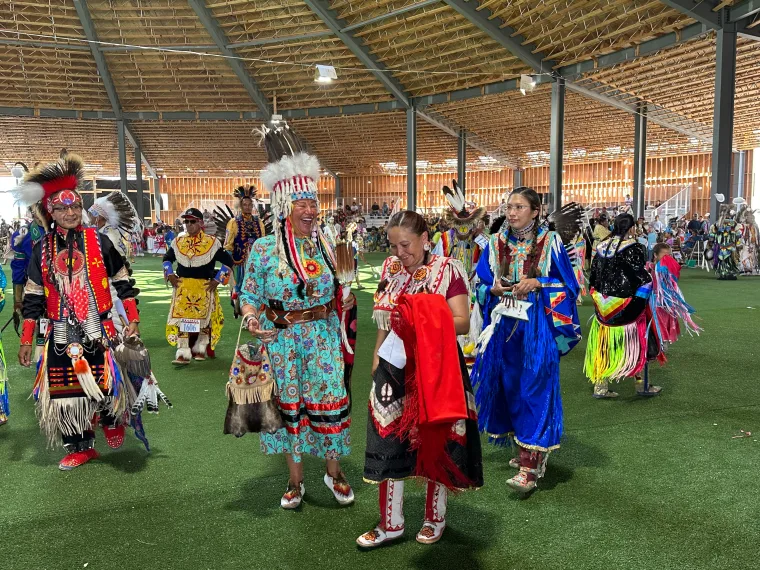Tribe, community comes together to rejoice in ‘Indian Days’
Created in 1954, the North American Indian Days celebration welcomes all to participate in singing, dancing and competition to heal and reconnect
JoVonne Wagner
ICT

North American Indian Days attendees stand for the color guard during grand entry on Friday, July 7, 2023 in Browning, MT. (JoVonne Wagner, ICT)
Thousands gathered in Browning, Montana over the weekend to reconnect and celebrate the history and culture through song and dance, competitions and remembering, during the 69th annual North American Indian Days.
Indian Days is a four-day celebration in the heart of the Blackfeet Nation. This year’s event featured powwow dancers, vendors and visitors from across the state and throughout Indian Country.
The powwow began on the first Thursday of July but Indian Day events took place all week, starting with a Youth Day, Veterans Powwow, and Independence Day activities. The powwow was accompanied by the North American Indian Days rodeo which features infamous and competitive Indian relay horse races.
Family tents and teepees decorated the campground and surrounded the huge new arbor as the muffled sounds of the drumbeats and jingle dresses filled the atmosphere. On its hottest day of 85 degrees and rising, children and adults carried around their favorite powwow snacks and drinks to keep them cool.
Out-of-town family and friends embraced and chuckled as they reunited and caught up with one another and visited about this year’s celebrations with the new arbor being a topic of conversation.
This was the first year that the powwow utilized the new multipurpose arbor that had just finished its first phase of construction. The $9 million arbor is huge and has exceeded the space of the former version with nearly 42,000 square feet. In phase two of construction, set to start soon now that Indian Days has completed, will have insulated walls, two garage door entrances as well as heating and cooling and built-in stands.

“I love it. It’s a lot cooler. Normally grand entry, you’re sweating, sun’s beaten down on you. This gives us relief from the heat and there’s a little bit of a breeze that comes through every now and then,” said Marilyn Cantois, Saulteaux Anishinaabe, who came from Alberta with her family to participate in the powwow. “I like the dance floor. It’s nice and soft and just really even, it’s gonna be a good time out there dancing.”
With all the new and continued events and celebrations to look forward to, this year also gave reason to pause and reflect back on the history of Indian Days and the Blackfeet Nation. The late Blackfeet Chief, Earl Old Person was honored this year with a memorial highway dedication where tribal and political officials unveiled new highway signs on the first day of the powwow.
Old Person, who played many roles as the Blackfeet Nation’s leader, also contributed to the origin of North American Indian Days. The celebration itself was born in 1954 from a similar gathering hosted in Sheridan Wyoming called the All American Indian Days.
Before his passing, Lea Whitford, a former Montana senator and tribal citizen, interviewed the chief about the history of the Blackfeet hosted powwow and shared one of the reasons behind its creation.
“There was a big celebration down in Wyoming and they asked him and he was there. He attended it and they asked him if he would start one up in this area,” Whitford said. “So that’s why it goes by North American Indian Days, because it was the only one at the time, the only big celebration like that. He said that a part of why they did that was because traditionally we’ve always gathered during the summertime and had our summer celebration ceremonies.”

From Whitford’s interview, Old Person believed that North American Indian Days’ purpose was to reconnect to past ways of life, which included basing the site of the campground on their traditional encampments. He believed it was also a way to invite outsiders in as a form of understanding during a time where celebrating and practicing tradition culture was encouraged.
“They wanted to open it up so that people would learn about us and learn more about who we were as Native Americans,” Whitford said. “So that celebration was started in order for people to get to know that group of people and the culture and that they have like a relationship building, if you will, taking place.”
Whitford said she still sees the late chief’s purpose of welcoming in everyone to celebrate in the current powwow, rodeo events, and horse culture.
“I think the spirit and intent of what was happening in the 1950s is what we still continue today, is we invite everybody to come and celebrate with us,” Whitford said.
The camps welcomed over 600 registered dancers as well as around 2,000 in attendance throughout the long weekend to gather, sing, sell, dance and rodeo.
Three friends, Siliye Pete, Bitterroot Salish, from Arlee, Jesenia Velez Blackweasel, Blackfeet, from Browning and Dana Sotomish, Nez Percé, from Lapawai, were seen laughing together and said they came to Indian Days to dance. They shared that they don’t often get to see each other but during the powwow season.

Vendors Julius Curtis and Rosita Todachine traveled from Mesa, Arizona to the powwow and sold their jewelry with colorful intricate beadwork and metal work displayed on every corner of their stand called Nizhoni Rose Jewelry.
Theda New Breast, who is a member of the Blackfoot Confederacy Womens Standup Headdress Society, gave more context on what the powwow itself means for the community, saying it is a time for healing.
“We’ve always been here before the United States and before Canada, and we always gathered, that’s why it’s a holy time, even in 2023,” New Breast said. “This is a holy time and by holy, that means that everybody needs to come with a good heart in their prayers and that we should recognize our traditional practitioners, our traditional societies, and our traditional leaders.”
According to New Breast, Indian Days, along with more traditional ceremonies like the Medicine Lodge ceremony, are opportunities to be role models within the community that encourages sobriety and clarity. The Blackfeet tribe bans all alcohol sales on the reservation for the duration of the powwow.

“We have to role model the behavior that we want people to have, of kindness, of helping each other, about being proud,” New Breast said.
Being proud was a theme seen throughout the long weekend at the campgrounds, arbor and rodeo arena. It’s also something that Blackfeet Tribal Business Councilman Lauren Monroe Jr. agreed with.
“The celebrations like this really encapsulates, I think, what it means to be Blackfoot, to feel good about being Blackfoot or Blackfeet and we don’t have to ask permission from nobody to feel good about being who we are,” Monroe Jr. said.
Monroe Jr. said Indian Days was born from the traditional religious ceremonies but now events are open and social which he believes the community benefits from.
“Now it’s really transformed into this really open invitation for anyone to really come here. you don’t just have to be Blackfeet, you don’t even have to be Indian, you just come and enjoy the dancing, the singing, and just be a participant. Everyone’s very happy and there’s a lot of feasting and storytelling and things like that and it’s really welcoming,” Monroe Jr. said. “That’s kind of where I think we’re at now in this turning point for us as people, because it’s an economic opportunity as well to share a bit of our culture and invite people to our homelands.”
North American Indian days are celebrated in the first few weeks of July. For more information on future celebrations, can visit the Facebook page or the Blackfeet Tribes website.

